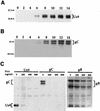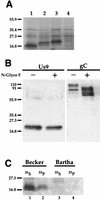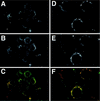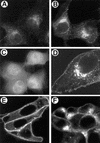The Us9 gene product of pseudorabies virus, an alphaherpesvirus, is a phosphorylated, tail-anchored type II membrane protein
- PMID: 9573219
- PMCID: PMC109967
- DOI: 10.1128/JVI.72.6.4560-4570.1998
The Us9 gene product of pseudorabies virus, an alphaherpesvirus, is a phosphorylated, tail-anchored type II membrane protein
Abstract
The Us9 gene is highly conserved among the alphaherpesviruses sequenced to date, yet its function remains unknown. In this report, we demonstrate that the pseudorabies virus (PRV) Us9 protein is present in infected cell lysates as several phosphorylated polypeptides ranging from 17 to 20 kDa. Synthesis is first detected at 6 h postinfection and is sensitive to the DNA synthesis inhibitor phosphonoacetic acid. Unlike the herpes simplex virus type 1 Us9 homolog, which was reported to be associated with nucleocapsids in the nuclei of infected cells (M. C. Frame, D. J. McGeoch, F. J. Rixon, A. C. Orr, and H. S. Marsden, Virology 150:321-332, 1986), PRV Us9 localizes to the secretory pathway (predominately to the Golgi apparatus) and not to the nucleus. By fusing the enhanced green fluorescent protein (EGFP) reporter molecule to the carboxy terminus of Us9, we demonstrated that Us9 not only is capable of targeting a Us9-EGFP fusion protein to the Golgi compartment but also is able to direct efficient incorporation of such chimeric molecules into infectious viral particles. Moreover, through protease digestion experiments with Us9-EGFP-containing viral particles, we demonstrated that the Us9 protein is inserted into the viral envelope as a type II, tail-anchored membrane protein.
Figures








Similar articles
-
Directional transneuronal infection by pseudorabies virus is dependent on an acidic internalization motif in the Us9 cytoplasmic tail.J Virol. 2000 May;74(10):4549-61. doi: 10.1128/jvi.74.10.4549-4561.2000. J Virol. 2000. PMID: 10775591 Free PMC article.
-
Intracellular trafficking and localization of the pseudorabies virus Us9 type II envelope protein to host and viral membranes.J Virol. 1999 May;73(5):4372-84. doi: 10.1128/JVI.73.5.4372-4384.1999. J Virol. 1999. PMID: 10196335 Free PMC article.
-
Visualization of an alphaherpesvirus membrane protein that is essential for anterograde axonal spread of infection in neurons.mBio. 2012 May 2;3(2):e00063-12. doi: 10.1128/mBio.00063-12. Print 2012. mBio. 2012. PMID: 22448044 Free PMC article.
-
Comparison of the pseudorabies virus Us9 protein with homologs from other veterinary and human alphaherpesviruses.J Virol. 2009 Jul;83(14):6978-86. doi: 10.1128/JVI.00598-09. Epub 2009 May 6. J Virol. 2009. PMID: 19420087 Free PMC article.
-
The role of virion membrane protein endocytosis in the herpesvirus life cycle.J Clin Virol. 2000 Aug;17(2):69-82. doi: 10.1016/s1386-6532(00)00084-6. J Clin Virol. 2000. PMID: 10942087 Review.
Cited by
-
Construction of varicella-zoster virus recombinants from parent Oka cosmids and demonstration that ORF65 protein is dispensable for infection of human skin and T cells in the SCID-hu mouse model.J Virol. 2003 May;77(10):6062-5. doi: 10.1128/jvi.77.10.6062-6065.2003. J Virol. 2003. PMID: 12719598 Free PMC article.
-
Role of pseudorabies virus Us9, a type II membrane protein, in infection of tissue culture cells and the rat nervous system.J Virol. 2000 Jan;74(2):834-45. doi: 10.1128/jvi.74.2.834-845.2000. J Virol. 2000. PMID: 10623746 Free PMC article.
-
Copatching and lipid raft association of different viral glycoproteins expressed on the surfaces of pseudorabies virus-infected cells.J Virol. 2004 May;78(10):5279-87. doi: 10.1128/jvi.78.10.5279-5287.2004. J Virol. 2004. PMID: 15113909 Free PMC article.
-
The pseudorabies virus Us2 protein, a virion tegument component, is prenylated in infected cells.J Virol. 2003 Nov;77(22):12285-98. doi: 10.1128/jvi.77.22.12285-12298.2003. J Virol. 2003. PMID: 14581565 Free PMC article.
-
Directional transneuronal infection by pseudorabies virus is dependent on an acidic internalization motif in the Us9 cytoplasmic tail.J Virol. 2000 May;74(10):4549-61. doi: 10.1128/jvi.74.10.4549-4561.2000. J Virol. 2000. PMID: 10775591 Free PMC article.
References
-
- Babic N, Klupp B, Brack A, Mettenleiter T C, Ugolini G, Flamand A. Deletion of glycoprotein gE reduces the propagation of pseudorabies virus in the nervous system of mice after intranasal inoculation. Virology. 1996;219:279–284. - PubMed
Publication types
MeSH terms
Substances
Grants and funding
LinkOut - more resources
Full Text Sources
Other Literature Sources
Research Materials

